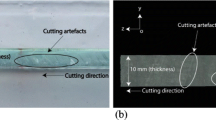Abstract
Processing procedures have been developed that produce stress distributions in glass with a maximum compressive stress below the surface. These glasses can exhibit rising apparent fracture toughness behavior and reduced strength variability associated with the stable growth of surface cracks under applied tensile stress. A weight function approach was used to determine stress intensity factors as a function of crack geometry for surface cracks under the effects of stress distributions similar to those found in these glasses. These calculations were then used to predict the growth behavior of surface cracks as a function of the applied and residual stress fields.
Similar content being viewed by others
References
Kistler, S.S (1962). Stresses in glass produced by nonuniform exchange of monovalent ions. Journal of the American Ceramic Society 45, 59–68.
Nordberg, M.E., Mochel, E.L., Garfinkel, H.M. and Olcott, J.S. (1964). Strengthening by ion exchange. Journal of the American Ceramic Society 47, 215–219.
Bartholomew, R.F. and Garfinkel, H.M. (1980). Glass Science and Technology Volume 5: Elasticity and strength in glasses, Chapter 6: Chemical strengthening of glass, Academic Press.
Green, D.J. and Maloney, B.R. (1986). Influence of surface stress on indentation cracking. Journal of the American Ceramic Society 69, 223–225.
Tandon, R., Green, D.J. and Cook, R.F. (1993). Strength variability in brittle materials with stabilizing and destabilizing resistance fields. Acta Metallurgica et Materialia 41, 399–408.
Tandon, R. and Green, D.J. (1991). Crack stability and t-curves due to macroscopic residual compressive stress profiles. Journal of the American Ceramic Society 74, 1981–1986.
Tandon, R. and Green, D.J. (1992). The effect of crack growth stability induced by residual compressive stresses on strength variability. Journal of Materials Research 7, 765–771.
Green, D.J. Tandon, R. and Sglavo, V.M. (1999). Crack arrest and multiple cracking through the use of designed residual stress profiles. Science 283, 1295–1297.
Sglavo, V.M. and Green, D.J. (2001). Flaw-insensitive ion-exchanged glass: II, Production and mechanical performance. Journal of the American Ceramic Society 84, 1832–1838.
Sglavo, V.M. and Bonafini, M. (2000). Design and production of a high reliability soda-lime silicate glass. In: G. Müller, ed. Ceramics – Processing, Reliability, Tribology and Wear. Wiley-VCH pp. 353–358.
Abrams, M.B., Green, D.J. and Glass, S.J. (2003). Fracture behavior of engineered stress profile soda lime silicate glass. Journal of Non-Crystalline Solids 321, 10–19.
Shen, J. and Green, D.J. (2003). Variable-temperature ion-exchanged engineered stress profile (ESP) glasses. Journal of the American Ceramic Society 86, 1979–1981.
Sglavo, V.M., Larentis, L. and Green, D.J. (2001). Flaw-insensitive ion-exchanged glass: I, Theoretical aspects. Journal of the American Ceramic Society 84, 1827–1831.
Green, D.J. (2003). Critical parameters in the processing of engineered stress profile glasses. Journal of Non-Crystalline Solids 316, 35–41.
Tandon, R. and Green, D.J. (1990). Indentation behavior of ion-exchanged glasses. Journal of the American Ceramic Society 73, 970–977.
Green, D.J. and Tandon, R. (1989). Surface stress effects in indentation fracture. In: K. Salama et al.,eds.Advances in Fracture Research, Vol. 4. Pergamon pp. 2757–2768.
Lube, T. (2002). A Knoop-indentation method for r-curve determination. Fracture Mechanics of Ceramics 13, 447–455.
Glinka, G. and Shen, G. (1991). Universal features of weight functions for cracks in mode I. Engineering Fracture Mechanics 40, 1135–1146.
Wang, X. and Lambert, S.B. (1995). Stress intensity factors for low aspect ratio semi-elliptical surface cracks in finite-thickness plates subjected to nonuniform stresses. Engineering Fracture Mechanics 51, 517–532.
Shen, G. and Glinka, G. (1991). Weight functions for a surface semi-elliptical crack in a finite thickness plate. Theoretical and Applied Fracture Mechanics 15, 247–255.
Pommier, S., Sakae, C. and Murakami, Y. (1999). An empirical stress intensity factor set of equations for a semi-elliptical crack in a semi-infinite body subjected to a polynomial stress distribution. International Journal of Fatigue 21, 243–251.
Raju, I.S. and Newman, J.C. Jr. (1979). Stress-intensity factors for a wide range of semi-elliptical surface cracks in finite-thickness plates. Engineering Fracture Mechanics 11, 817–829.
Fett, T. and Munz, D. (1997). Stress Intensity Factors and Weight Functions. Computational Mechanics Publications.
Wiederhorn, S.M. and Lawn, B.R. (1979). Strength degradation of glass impacted with sharp particles: I, Annealed surfaces. Journal of the American Ceramic Society 62, 66–70.
Author information
Authors and Affiliations
Rights and permissions
About this article
Cite this article
Abrams, M., Green, D. Prediction of stable crack growth geometry in residually stressed glass. International Journal of Fracture 130, 601–615 (2004). https://doi.org/10.1023/B:FRAC.0000049503.04526.ca
Issue Date:
DOI: https://doi.org/10.1023/B:FRAC.0000049503.04526.ca




